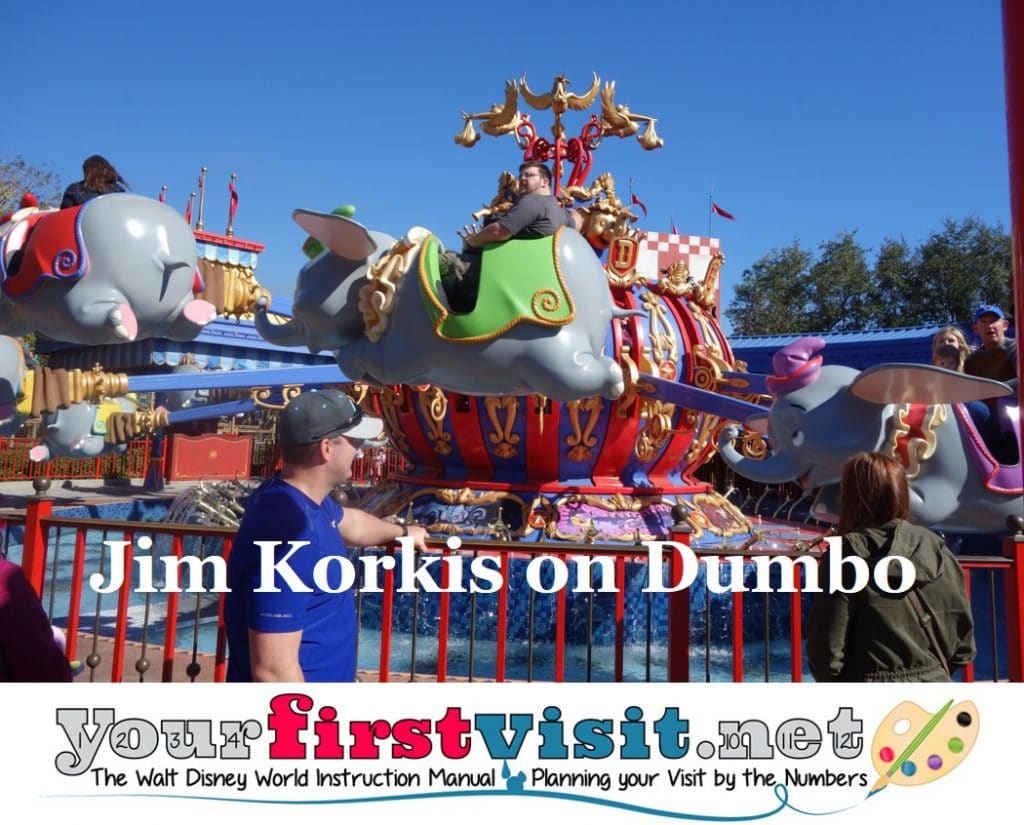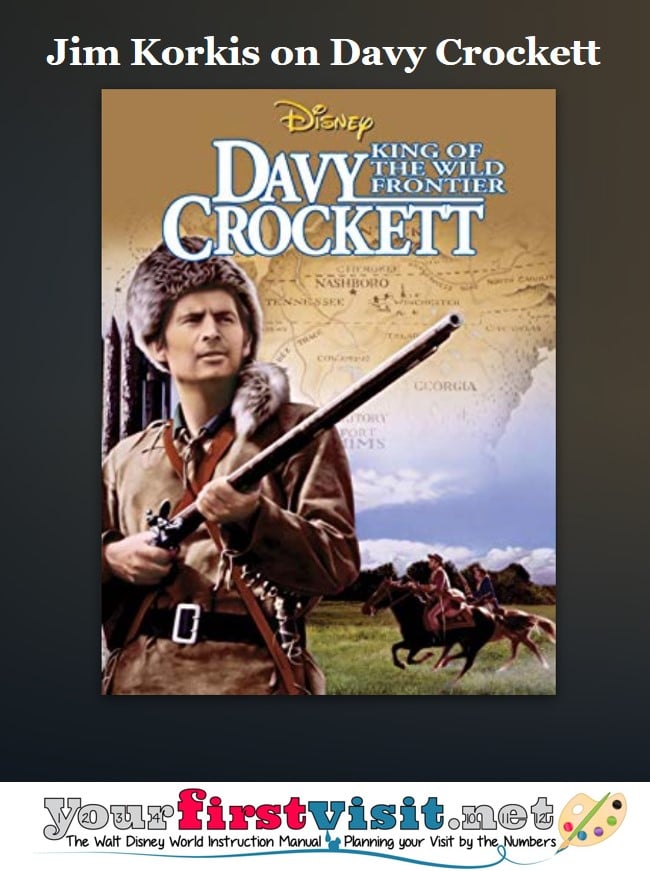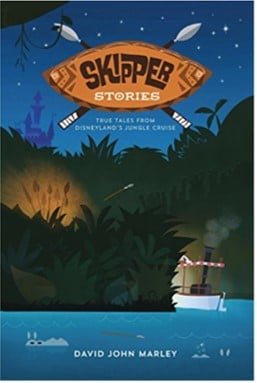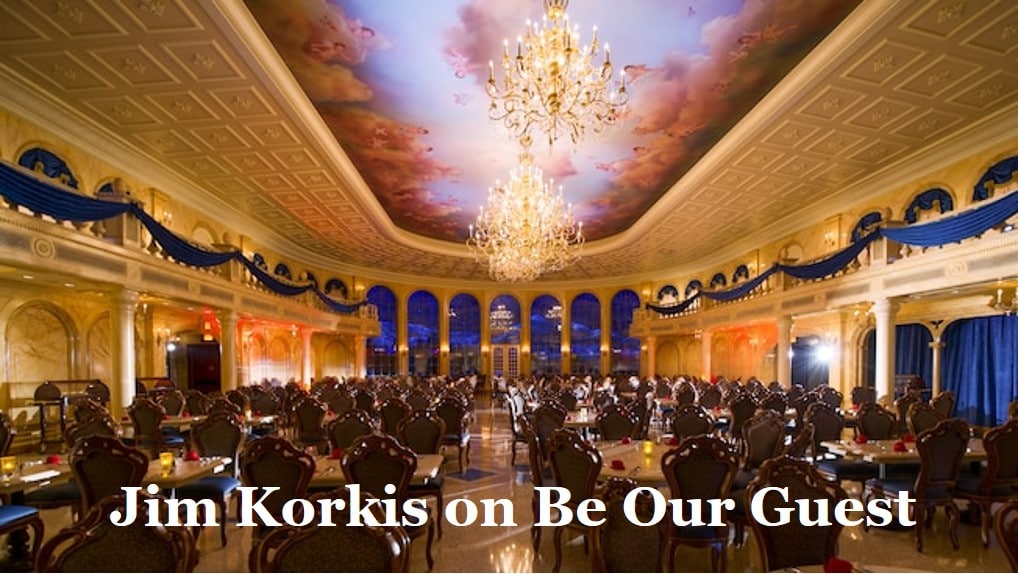Category — A Friday Visit with Jim Korkis
A Friday Visit with Jim Korkis: David John Marley on the Jungle Cruise
Welcome back to Fridays with Jim Korkis! Jim, the dean of Disney historians, writes about Walt Disney World history every Friday on yourfirstvisit.net.
YOUR PERSONAL DISNEY LIBRARY (16)
By Jim Korkis
- Skipper Stories: True Tales from Disneyland’s Jungle Cruise and
- More Skipper Stories by David John Marley
Walt Disney once famously said that it takes people to make the dream a reality, and that is certainly true of the cast members who work at the Disney theme parks. In fact, for some attractions like the Haunted Mansion and the Tower of Terror, the personalities of the individual cast members add tremendously to the overall experience.
However, the one attraction that has always been dependent upon the personality of a cast member is the iconic Jungle Cruise in Adventureland. It is infamous for its bad puns and corny jokes that developed almost from the opening of the ride in 1955.
Being a Jungle Cruise skipper is considered one of the prime and most coveted positions for a cast member.
David John Marley was a Disneyland skipper on the Jungle Cruise for three years. Currently, he is a professor at California State University, Fullerton with a background in history.
He had the idea to contact dozens of former Jungle Cruise skippers who worked the attraction over six decades to create an anecdotal oral history recounting humorous and horrific tales of working on the ride. The result is a fascinating and entertaining glimpse into the life of a Disney cast member.
Some former skippers asked that they remain anonymous as they shared their tales, but the overwhelming majority are identified by their entire name and by decade. Interestingly, some of the current skippers had to have their thoughts reviewed by Disney Media Relations.
The book is divided into twenty-three short chapters devoted to different topics from training to interactions with guests to accidents and much more. Each chapter is filled with many different skippers offering a paragraph or two discussing their personal experiences about that topic.
Marley allows each participant to tell their own story without any interjection from himself. However, Marley does share a few of his own stories just like the other skippers.
Not all of the memories are memorable, or in some cases even that interesting, but those that aren’t help provide a wider perspective, and make those that are amusing stand out even more.
Those funny moments run the gamut from the clueless questions asked by guests (“Is that water real?” “Where is Adventureland?”) to the various pranks devised by the skippers (like the five gallon jug of liquid soap that was dumped into the water, transforming the river into a bubble bath, or the skipper who showed up in the elephant bathing pool one trip wearing just his boxer shorts and holding a bar of soap).
Marley even had Jason Schultz from the Richard Nixon Presidential Library dig out information about a former skipper, Ron Ziegler, who later became Nixon’s press secretary.
The book was so well received that a sequel following the same format, More Skipper Tales, was released in December 2018.
Thankfully, these books debunk the theory that what happens in the jungle stays in the jungle.
* * * * *
Thanks, Jim! And come back next Friday for more from Jim Korkis!
In the meantime, check out his books, including his latest, The Vault of Walt Volume 7: Christmas Edition, and his Secret Stories of Walt Disney World: Things You Never You Never Knew, which reprints much material first written for this site, all published by Theme Park Press.
Follow yourfirstvisit.net on Facebook or Twitter or Pinterest!!
April 19, 2019 No Comments
A Friday Visit with Jim Korkis: Dumbo the Ride
Welcome back to Fridays with Jim Korkis! Jim, the dean of Disney historians, writes about Walt Disney World history every Friday on yourfirstvisit.net.
DUMBO AT THE MAGIC KINGDOM
By Jim Korkis
One of the most popular attractions at Disney theme parks is Dumbo, inspired by the 1941 animated feature of the little elephant who, thanks to his large ears, could take flight into the skies. It was one of the original attractions at Disneyland.
Dumbo is known as a “hub and spoke” attraction because the ride vehicles rotate on an articulated armature connected to a central hub. Guests use a lever inside the vehicle that operates a hydraulic ram to control the vertical height. For decades, all versions rotated counterclockwise.
When the attraction first opened at Walt Disney World, the elephants were missing their hats and the attraction was missing the iconic Timothy Mouse figure who was added about two years later. In 1993, the attraction was expanded to sixteen vehicles to meet the demand for the ninety-second ride.

Magic Kingdom’s Fantasyland underwent a large expansion and renovation that resulted in Storybook Circus being added to the area in 2012. The Dumbo attraction was moved to this new section with a new interactive, enclosed queue resembling a Big Top circus tent that serves as a playground, as well as water fountains that change colors at night.
The original Dumbo carousel spinner closed on January 8, 2012. The new spinner (the first Dumbo ever to spin clockwise) soft-opened on March 12, 2012. The original spinner was refurbished to match the new theming of the attraction and be a fraternal twin of the new spinner. That new spinner soft-opened on June 15, 2012. Richer paint shades were used and the bottom of Dumbo’s feet are now pink.
The new attraction’s two spinners separated by about fifty feet rotate in opposite directions, so that those looking at the middle of the attraction will see elephants moving toward them on both sides of the walkway.
Timothy Q. Mouse, an iconic part of the original attraction, was moved to the entrance archway. “We cleaned him up and moved him over,” Imagineer creative director Chris Beatty said. “He’s such a neat ambassador.”
Timothy holds a representation of the magic feather seen in the film, rotates atop the sign, and bows toward each half of the attraction. The back of the sign reads “Believe & Soar!”
High in the play tent queue is a flying Dumbo and Timothy Mouse. The area includes a tall burning-building set as seen in the film — the climactic scene where the title character discovered he could fly.
Pull a cord near the fireworks display to set off a light show with strobes. Benches line the outer edge, providing rest for parents who have been given a ticket-themed pager to let them know when their group can board the ride.
A center ring, designed primarily for 2- to 3-year-olds, has interactive elements such as a little fire truck with horn, tap-touch lights and various cranks. Step on animal prints and it creates noises.
The Dumbo attraction inspired imitations at other amusement venues such as Bulwagi’s Flying Adventure at Lion Country Safari in Loxahatchee, Florida; Amazing Flying Elephants at Dollywood in Pigeon Forge, Tennessee; and Elephant March at Silver Dollar City in Branson, Missouri.
* * * * *
Thanks, Jim! And come back next Friday for more from Jim Korkis!
In the meantime, check out his books, including his latest, The Vault of Walt Volume 7: Christmas Edition, and his Secret Stories of Walt Disney World: Things You Never You Never Knew, which reprints much material first written for this site, all published by Theme Park Press.
Follow yourfirstvisit.net on Facebook or Twitter or Pinterest!!
April 12, 2019 No Comments
A Friday Visit with Jim Korkis: Test Track at Epcot
Welcome back to Fridays with Jim Korkis! Jim, the dean of Disney historians, writes about Walt Disney World history every Friday on yourfirstvisit.net.
TEST TRACK AT EPCOT
By Jim Korkis
The Test Track attraction that replaced the original World of Motion attraction at Epcot officially opened March 1999. Test Track then was closed in 2012 for renovations, and re-opened in December 2012.
The up-to-65 mph speed track of almost a mile in length remained much the same in the 2012 renovation, with the major change being the storyline.

The first version of the Test Track attraction was notorious for its many delays before opening. Among other things, the original wheels and axles on the cars could not handle the speed demands, and the original ride programming system couldn’t handle the number of cars needed for the highest capacity since each car had three on-board computers. Re-setting after a shutdown could take up to an hour. The challenges were eventually resolved and the attraction was one of the first at Disney parks to have a single rider line.
Kevin Rafferty was the Walt Disney Imagineering Senior Show Writer for the original attraction. As a young man, he worked at Disneyland’s Plaza Inn washing dishes. His dream was to be an animator, and he was a week away from an interview with Disney Feature Animation when he saw an opening in the Art Services Department at Walt Disney Imagineering, and his portfolio and prior Disney work experience were enough to get him the job.
Rafferty recalled the creation of the original attraction: “The Test Track attraction isn’t very story dependent. The story is that there are more than 15,000 parts that go into every new GM car and truck and that before they arrive in the showrooms, each and every new part has been tested…and re-tested in labs by technicians and out on test tracks by professional test drivers.
“The attraction story is basically all about this vehicle testing and that you, the guest, get to experience what it’s like to be a test driver.
“My role began from the spark of the idea before we landed on Test Track, when a core group of us were discussing what we could do to refurbish the original World of Motion attraction presented by GM that no longer wanted to sponsor the ride.
“We ran a few of our initial ideas past some GM executives and they challenged us with the thing Imagineers love to hear: ‘What if you guys started from scratch on this? What would you do?’ GM had mentioned to us that their ‘story’ is not only about manufacturing but it’s about testing.
“Then we were faced with ‘How could we make an attraction out of that?’ We immediately began talking about a test track-like ride idea and came up with the concept and logical story.
“GM invited us out on a research trip to several of their proving grounds, including their main test track facility in Milford, Michigan. After spending a day riding with professional test drivers and experiencing the rigors of their daily schedule, including driving over rough roads, braking, road handling and speeding along their four mile speed loop, our idea was validated.
“It was my job to help design and develop a logical scene-by-scene story progression throughout the attraction and then write the plaque copy and scripts for the pre-show ‘lab’ exhibits and videos, the ‘briefing room’ (with actor John Michael Higgins, playing director of operations Bill McKim) and ride narration, as well as pitching the idea’s progression to our management along the way. By the way, this also includes riding the ride a zillion times before opening to test and adjust the show and ride timing.”
* * * * *
Thanks, Jim! And come back next Friday for more from Jim Korkis!
In the meantime, check out his books, including his latest, The Vault of Walt Volume 7: Christmas Edition, and his Secret Stories of Walt Disney World: Things You Never You Never Knew, which reprints much material first written for this site, all published by Theme Park Press.
Follow yourfirstvisit.net on Facebook or Twitter or Pinterest!!
April 5, 2019 No Comments
A Friday Visit with Jim Korkis: Davy Crockett at Walt Disney World
Welcome back to Fridays with Jim Korkis! Jim, the dean of Disney historians, writes about Walt Disney World history every Friday on yourfirstvisit.net.
DAVY CROCKETT AND WALT DISNEY WORLD
By Jim Korkis
Davy Crockett was a real 19th century American folk hero noted for his life as a frontiersman. In 1954, for his new weekly television show, Walt Disney dramatized the life of Crockett, who was played by actor Fess Parker.

Davy Crockett’s Ranch (originally called Camp Davy Crockett) is a campground at Disneyland Paris and was the first resort to open there.
Of course, Walt Disney World is also home to Davy Crockett inspired items.
Davy Crockett Explorer Canoes debuted in Frontierland on opening day at Walt Disney World in 1971. The 35-foot long canoes travelled along the same path as other watercraft on the Rivers of America, like the long-gone Mike Fink River Keel Boats from the Disney television show about Crockett.
That trip included a glimpse of Wilson’s Cave Inn that was also inspired by Disney’s Davy Crockett and the River Pirates (1955). Each canoe required two cast members, making the attraction expensive to operate in relation to its capacity, so it closed in 1994.
Pecos Bill Tall Tale Inn & Café that opened in Frontierland in 1998 includes as among its many artifacts left in the restaurant by Bill’s famous friends Davy Crockett’s satchel and powder horn, as well as a version of Davy’s encounter with Big Foot Mason, hand written by Georgie Russel.
Across Walt Disney World, there are American Amusement Machine Association Non-Violent rated Arcade Games that use rechargeable play cards.
At Fort Wilderness Campground, Daniel Boone’s Wilderness Arcade is located near the Meadow Swimmin’ Pool while Davy Crockett’s Wilderness Arcade is over by Pioneer Hall. Both feature a variety of classic and contemporary games.
The finale of the “Hoop-Dee-Doo Musical Revue” at Pioneer Hall includes a sketch accompanied by the famous Disney Davy Crockett theme song.
However, a hidden treasure missed by most guests is Crockett’s Tavern. Opened in 1985, it is an extension of the Trail’s End restaurant but is only open in the afternoon and early evening. It is a nostalgic full-service bar capturing the spirit of the untamed wilderness of the late 1880s and its famous namesake. It offers adult beverages like beer and wine as well as a variety of snacks like pizza, nachos, and chicken wings.
The tavern is made of natural wood and glass and while it has indoor seating, many guests prefer the outside covered porch and the oversized rustic rocking chairs.
Dale Moore, Manager of Resort Design, who was given the job for creating the tavern, was a huge Davy Disney Crockett fan, so he included a lot of “Crockettana” for observant fans. A small replica of the Gully Whumper keel boat from the TV show, and paintings of Fess Parker as Davy and Buddy Ebsen as Georgie can be found, as well as a replica of Crockett’s famous rifle, Old Betsy.
An imposingly terrifying stuffed grizzly bear stands next to a glassed-in display featuring the classic 1843 portrait of the real Davy Crockett, a coonskin cap, letters and other items.
The portrait of Andrew Jackson, who Davy served under during the Creek Wars, was painted by Priscilla Russ, a Senior Artist at WDW Marketing. She wanted to do it in dark brown sepia tones to capture a sense of the era but neither acrylics or water colors would resist fading with time.
Even her attempts experimenting with Doc Martin dyes weren’t satisfactory, so she ended up creating an ink that had a secret ingredient, coffee grounds, and her likeness of Old Hickory has stood the test of time.
* * * * *
Thanks, Jim! And come back next Friday for more from Jim Korkis!
In the meantime, check out his books, including his latest, The Vault of Walt Volume 7: Christmas Edition, and his Secret Stories of Walt Disney World: Things You Never You Never Knew, which reprints much material first written for this site, all published by Theme Park Press.
Follow yourfirstvisit.net on Facebook or Twitter or Pinterest!!
March 29, 2019 No Comments
A Friday Visit with Jim Korkis: Joe Rohde on the Yeti and Expedition Everest
Welcome back to Fridays with Jim Korkis! Jim, the dean of Disney historians, writes about Walt Disney World history every Friday on yourfirstvisit.net.
THE YETI AND EXPEDITION EVEREST IN DISNEY’S ANIMAL KINGDOM
By Jim Korkis
When the Expedition Everest attraction opened officially at Disney’s Animal Kingdom in June 2006, the Yeti it included was the largest and most complex audio-animatronics figure ever built by Walt Disney Imagineering.

However, with a big Walt Disney World anniversary celebration coming up and with the success of Pandora drawing huge crowds to Disney’s Animal Kingdom, rumors have once again started that the attraction could be closed for a few months for a rehab and to finally fix the creature.
On April 3, 2006, while working at Walt Disney World, I was able to attend a presentation with Imagineer Joe Rohde where he talked about the new attraction and, in particular, the Yeti. Here is a short excerpt from that presentation transcribed by Wayne Campbell from my copy.
Joe Rohde:
The Yeti mandir (Hindu temple) shows the Yeti as a fierce protector of the mountain. Everywhere you look there are carvings of Yeti, so it is the Yeti mandir. This bronze of the physical Yeti is in the traditional pose of any protector spirit with his one hand up holding this mountain in his hand and the other hand is out saying, “Stay out!”
So, anyway, all of this building sets a certain tone—and that’s the mythic, mystical tone of the legend of the Yeti. The other place is The Yeti Museum. The Yeti Museum, basically, is another way of telling the story. “This is the Himalayas…they all have this legend of the Yeti…here’s what all that stuff looks like.” And then there’s the made-up stuff like the lost expedition.
The Himalayas really are a place with real bio-diversity. So it’s a place where plausibly there could be a Yeti and just because there’s really an animal doesn’t always mean you see it.
And, of course, then there’s the room where the proprietors of Himalayan Escapes—which I find to be a humorous name for a travel company where you end up escaping from the Yeti—basically disavow all that.
Finally, on the ride, you see the Yeti, guardian of the mountain, as real as we could make him be, and it is sort of both a revelation that the Yeti is real—that’s kind of a reward for your going through all the material in the queue and it is kind of the end of your mythic adventure that’s returning you back to the world of humanity—and you’re back to humanity almost like it was a dream, right? Like it almost didn’t happen, just like a fairy tale.
One of the animals that we looked at is this Szechuan golden snub-nosed monkey. They’re very, very rare. They stay in the snow all winter and they’ve adapted to this cold weather environment. And of course, they have big teeth and they’re creepy and their face is blue, which looks cold, and they’ve got hair all over and they’ve got this big mane.
So we basically took this monkey—the idea of this monkey—and we make it bigger and bigger and bigger and bigger and we took some ape-like characteristics and we blended them together to get our Yeti.
There’s too much evidence for some kind of real creature for there to be no real creature behind the legend of the Yeti. The Yeti used to live in the exact same area where the giant panda now lives today. And you know, the giant panda is a prehistoric animal, it just happens to be one that’s still alive. If the panda was extinct and people said they saw pandas, we’d be treating that like the Yeti.
So the legend of the Yeti, in my opinion, is a fusion of these oral traditions because the people moved away from the place where it used to be demonstrably true. As you move away, it becomes more abstracted.
* * * * *
Thanks, Jim! And come back next Friday for more from Jim Korkis!
In the meantime, check out his books, including his latest, The Vault of Walt Volume 7: Christmas Edition, and his Secret Stories of Walt Disney World: Things You Never You Never Knew, which reprints much material first written for this site, all published by Theme Park Press.
Follow yourfirstvisit.net on Facebook or Twitter or Pinterest!!
March 22, 2019 No Comments
A Friday Visit with Jim Korkis: Be Our Guest
Welcome back to Fridays with Jim Korkis! Jim, the dean of Disney historians, writes about Walt Disney World history every Friday on yourfirstvisit.net.
BE OUR GUEST IN FANTASYLAND
By Jim Korkis
The Be Our Guest Restaurant at the Magic Kingdom that opened in December 2012 was part of the larger New Fantasyland expansion and renovation of that area of the park.
When it opened, it was the only publicly accessible Magic Kingdom venue to serve wine and beer–until December 23, 2016, when other Magic Kingdom restaurants started offering the same options.
The goal in Be Our Guest was to capture the elegance and fairytale charm of Disney’s popular 1991 animated feature film Beauty and the Beast. The entrance with its cold hard stone, metal, and desaturated tones of crumbling architecture juxtaposed against beautiful landscaping, hints that this might be a time before the curse was broken as guests walk through the gates and across a stone bridge.
The lion-like figures flanking the entrance door were referred to by the Imagineer designers as “golions” referencing that they were a combination of goat and lion. The figures above the entrance door that resemble eagles with snake tails were called “sneagles”. The six stone gargoyle figures on the bridge leading to the castle were simply all given the name “Frank” in order to better identify them.
“This is a whole new level of theming for a Disney restaurant,” said Maribeth Bisienere, vice president of Food & Beverage and Merchandise for The Walt Disney Company. “More than ever, we’re using storytelling and creativity. From the moment they cross the bridge into the castle, it’s all about immersing our guests in the dining experience. Every detail is part of the story.”
Three distinctive dining areas are located within the castle: an elegant ballroom setting, the mysterious West Wing of the Beast’s castle with the enchanted rose under a glass bell jar using the Pepper’s Ghost illusion for its falling petals, and the stunning Rose Gallery with a seven foot tall wooden music box with a depiction of Belle and Beast dancing on top of it, while overhead is a dome that is an exact replica from the chapel de Saint Chapelle, the cathedral next to Notre Dame in Paris.
The centerpiece golden chandelier in the ballroom measures more than 12 feet tall and 11 feet wide. It boasts more than 84 candles and more than 100 jewels that hang down to give it added shine. The area is defined by a 20-foot high coffered ceiling painted with clouds and cherubs depicting the faces some of the Imagineers who worked on the project and a terrazzo floor. Beyond 18-foot-tall windows is the French countryside where snow falls gently against a starry night sky.
The Rose Gallery is adorned with paintings that celebrate the characters from the film, and with four tapestries inspired by background art from the film. Carved roses are featured throughout the room, along with other rose accents including the intricate tile mosaics on the floor.
The West Wing includes, over the fireplace, a portrait of the young prince in human form that has been slashed by the beast’s claws. With periodic flashes of lightning, the image in the portrait transforms from prince to Beast.
Music was integral to adding to the overall ambience. For the Ballroom, a 50-piece orchestra recorded the music from the film. In the adjacent Rose Gallery, special music box arrangements were recorded of the same pieces heard in the Ballroom, in perfect synchrony, so that guests moving from room to room hear the same tune transformed from one style to another. In the West Wing, a somber, melancholy arrangement creates a forbidding mood.
For four years, the Disney Food & Beverage team worked at creating a menu to match the environment. A team of Disney chefs, including longtime Disney Chef Roland Muller, a native of Alsace, France, developed the French-inspired dishes, creating both a quick-service menu for lunch and more elegant table-service menu for dinner.
“Our role was to finish the story,” said Walt Disney World Executive Chef Lenny DeGeorge.
* * * * *
Thanks, Jim! And come back next Friday for more from Jim Korkis!
In the meantime, check out his books, including his latest, The Vault of Walt Volume 7: Christmas Edition, and his Secret Stories of Walt Disney World: Things You Never You Never Knew, which reprints much material first written for this site, all published by Theme Park Press.
Follow yourfirstvisit.net on Facebook or Twitter or Pinterest!!
March 15, 2019 No Comments





